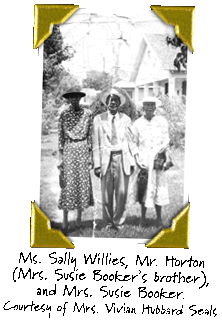

Home
| Contents | Next
School Days, School Days
For
many Independence Heights residents, their earliest
memories of the neighborhood focus on their school days.
The average child growing up in the City of Independence
Heights attended Mrs. Booker’s Kindergarten, the Independence
Heights School (later renamed Burrus Elementary), and
lastly, Booker T. Washington High School (previously
called Colored High).
|
| _____
Before
beginning elementary school, Mary Lee Taylor attended Mrs.
Booker’s kindergarten, which she recalls was “one room,
about the size of a garage.” When the children would act
up, Mrs. Booker “would get her switch and she would call
it ‘Brother Rabbit’.” Today, when Mrs. Taylor disciplines
her own grandkids, she says, “I’m going to get my ‘Brother
Rabbit’.” |
|
_____
Vivian
Seals fondly remembers her days at Mrs. Booker’s kindergarten.
Mrs. Seals recalls nearly all of the neighborhood children
attending the school, which was located in a building
directly behind its founder’s home. The founder, Susie
Horton Booker, who many children affectionately called
“Aunt Sue,” earned her teaching certificate from Prairie
View College before moving to Independence Heights in
1910.
_____
Mrs.
Booker’s commitment to the children was evident in her
generosity. She never refused children because of their
parents’ financial status. The school’s success was demonstrated
by the excellent preparation for elementary school that
the students received. Mrs. Booker’s kindergarten, now
called Williams Academy, still serves the Independence
Heights community.
|
 |
|
|
_____
By the
time a dozen or so families had moved into Independence
Heights, the need for an elementary school had become evident.
In 1911, with the help of Harris County, local leaders worked
to create a school at the 600 block of E. 39th street, and
a two-room building from the Sunset Heights community was
moved onto the site. The first teacher in the new Independence
Heights School was O.L. Hubbard, a graduate of Prairie View
College. |
| _____
As the
population increased, the student body outgrew its small
schoolhouse and classes had to be temporarily held in both
the New Hope Baptist Church building and in the General
Mercantile Store, By 1928, a new building for the school
was constructed on 33rd street, and P.H. Holden had become
the first principal. When it opened, the school was renamed
in honor of James D. Burrus, a former slave who became a
successful black educator. |
|
|
_____
For
high school classes, students attended Colored High, which
was established in 1892 and rebuilt (on the same site)
in 1927 to accommodate the growing numbers of students
(for more than 25 years it was Houston’s only high school
for African Americans). In 1928 it was renamed Booker
T. Washington. According to Mrs. Seals, the elementary
school that she attended in the First Ward, outside of
Independence Heights, was first named Booker T. Washington,
but its name was changed to Brock Elementary when the
high school took the elementary school’s former name.
_____
Booker
T. Washington, named for the famous leader, was the closest
high school to Independence Heights, but it was still
outside its city limits. Students had to take the streetcar
to the Fourth Ward where the school was located. In 1959,
the school moved to 39th Street, inside of Independence
Heights.
|
| _____
Many
of the neighborhood’s residents attended college,
but given the financial and racial constraints of the time,
most attended black colleges and universities. After Mrs.
Seals graduated from Booker T. Washington High School in
1933, she attended Houston Colored Junior College. According
to Mrs. Seals, this college was formed in 1927 after members
of the greater Houston African American community (including
Independence Heights) requested that a college for African
Americans be established in Houston. Although many members
of the Houston school district were against the idea, citing
that there were other black colleges nearby (the closest
was in Prairie View, 50 miles away), the school district
superintendent at the time, Edison Oberholtzer, agreed with
the petitioners. |
|
|
|
_____
In 1927,
Houston Colored Junior College was established under the
direction of the Houston Independent School District. Thus,
the tireless efforts of community leaders made a profound
impact on the educational opportunities of Houston African
Americans, by creating an institution where they could receive
advanced degrees. |
| _____
From
1927 to 1934, Houston Colored Junior College was run by
the Houston Independent School District. In 1934, it changed
from a 2-year institution into a 4-year college and became
the African American branch of the University of Houston.
At that time it was renamed Houston College for Negroes.
The university eventually became Texas Southern University. |
|
|
_____
Lota
McCullough Charles attended TSU and received a Bachelor
of Arts degree in Music Education. Her two older brothers
helped scrape together the money to pay for her first
two years of school. Mrs. Charles says, “There was just
a handful of us [black youth] that finished college.”
She recalls that even with a college degree, “The only
thing that a black woman could really do and make some
money was to be a teacher.”
_____
Helena
Allen does not recall having role models to encourage
her as a youth to aim for college. But Mrs. Allen still
had the self-determination to pursue a higher education.
While she was raising her children, Mrs. Allen returned
to school to become a geriatric nurse. She states that
she just had to find the time to study so that she could
achieve her dreams.
|
Home
| Contents | Back to Top
Next
|
 |